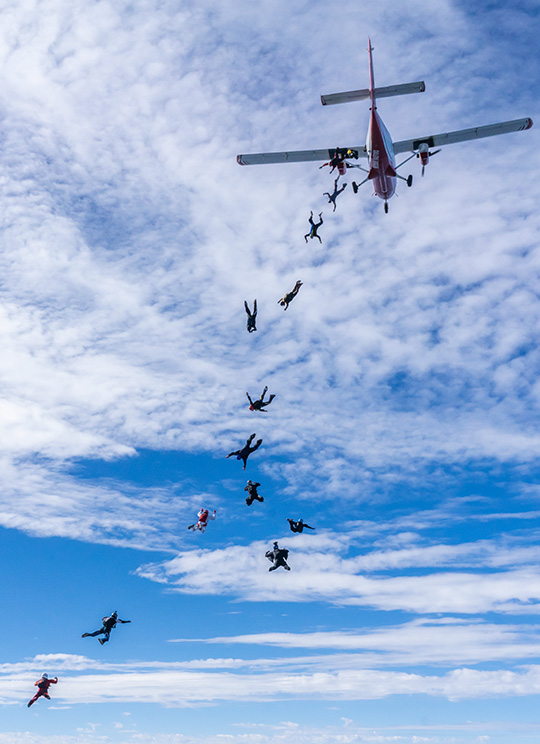Above: This 18-way perfectly illustrates the concept of quadrants. Photo by Elliot Byrd.
 The term exit frame refers to the position of the jumpers immediately after they leave the plane. Photo by Norman Kent.
The term exit frame refers to the position of the jumpers immediately after they leave the plane. Photo by Norman Kent.Let’s say you’re invited on a friend’s birthday jump at your home DZ. It’s a 15-way belly load, but your experience is limited to floating and diving on small formations. Your exits aren’t always the most graceful and one time after a rough and tumble exit, you went to the wrong side of the formation. To your credit, you’ve been taught how to inch your way down to your slot and get level before taking grips, but you could use some pointers on making better exits and getting down to the formation more effectively, especially on bigger formations.
Exits from side-door aircraft such as Twin Otters can be challenging for jumpers new to big-way formation skydiving. So here are some tips for making good exits and correcting bad ones, as well as information on what to do if the base funnels or rotates.
Terminology
Exit Frame
The exit frame refers to the position of all jumpers in the air immediately after exit. Imagine a video of the entire exit paused at the point where the last diver has left the plane. You would see jumpers spread out on the relative wind starting from the plane and stretching all the way down to the base and floaters, who are the farthest distance from the plane, vertically and horizontally (See photo right.)
Quadrant
Think of a quadrant as one-fourth of the completed formation, one-fourth of the pie, if you will. A quadrant includes part of the base and the jumpers who will be docking on and behind that part. It’s a simple concept that helps ensure a safe skydive by controlling traffic, meaning each jumper has a direct path to the formation and is less apt to collide with other jumpers (See photo above.)
Stadium Setup
This is the only way that jumpers should approach a big-way formation. They head to their quadrant and stop at a point above and outside the building formation. Then they incrementally work their way down to their slots. The location of their slots determines how far up and out they set up. Jumpers next to the base set up the closest while jumpers docking on the outside of the formation set up the highest and the farthest out. In this configuration, jumpers look like they are lined up in the seats of an imaginary football stadium (See photo below.)

During a big-way, jumpers approach the formation using a stadium setup. Photo by Craig O’Brien.
Tips for Good Exits
Part of becoming competent in big-ways is the ability to exit from anywhere in the lineup. Good exits contribute to quicker builds. Learn to float as well as dive. Learn to rear float, front float and middle float. As a diver, learn to exit close to the base and, as you gain confidence and experience, ask to be moved farther back in the lineup.
Diving Exits
Take baby steps. Shuffling to the door using small steps makes you less apt to step on or trip over the person in front of you. It also makes it less likely that the person behind you will trip over your trailing foot.
When diving out the door, present your torso to the relative wind (prop blast). It’s like a sideways Superman exit, where you glide smoothly on the relative wind as you locate the base and your quadrant before adjusting your dive (steeper or flatter) to get to where you need to be in the stadium setup.
To dive steeper, lower your head (while keeping the formation in sight) and extend your arms while pulling them back to your sides and then farther behind you, extending your legs as you do. To go even steeper, pull your arms back farther, but do not go completely vertical and lose sight of where you’re headed.
To dive flatter, start the same way you would for a steep dive but don’t lower your head as much or pull your arms back behind you. Keep your extended arms even with your sides. To go even flatter, push down with your arms and hands the way you would in a flat track.
To stop your dive (which you should do well above where you want to be completely stopped), flare – meaning spread your arms and legs out wide and push down with them. You will feel yourself decelerate and finally stop. It will probably take several jumps before you have a good idea of how soon to start your flare. But higher is better when you are starting out. The point to remember is that it takes a few seconds to bleed off the speed from your dive.
(For more details about diving on big-ways, consult an organizer or a big-way coach.)
Floating Exits
Some organizers put several floaters outside the plane, but for simplicity’s sake, let’s focus on the three most common types: front, middle, and rear. The middle floater is typically the base and gives the count upon which other floaters and early divers time their exits.
Timing is important for the front and rear floaters. Leave too soon and you might have a lot of vertical distance to make up. Plus, jumpers who are supposed to dock on you might not see you if you’re hundreds of feet below the action. Leave too late and you risk getting hit or bounced around by other jumpers leaving the plane.
Front and rear floaters should leave just slightly before the base. A good rule of thumb is to leave on the “set” portion of a “ready, set, go” type of count or at the end of the “leg in” portion of a “leg out, leg in, leg out” type of count. Different organizers use different types of counts, so be sure to practice your timing during the dirt dive.
There are a couple reasons why floaters should leave slightly ahead of the base. First of all, it prevents you from bumping into the base and knocking it off heading or—worse—funneling it. It also puts you slightly behind the base with plenty of clean air to track up and get slightly above the base and into your stadium setup. It might seem that leaving early would make you go low, but if you track up properly on the relative wind you will find yourself level with or above the base once it flattens out.
Bonus Tip for Front Floaters: Instead of simply dropping off the plane, push off with your right leg and right arm (if jumping from left door aircraft). That way if you are a little late, you won’t interfere with the base and are not likely to get bumped by divers as they leave the plane.
If You Have a Bad Exit
A bad exit doesn’t mean you’ve ruined the jump for everyone else. As long as you remain calm and remember where you are supposed to go, including jumpsuit colors, you have time to take corrective action and get down to the formation in time.
Your first course of action is to stop tumbling and get your body flying stable. This might require practicing what you were taught as a student to stop spinning or falling on your back: ball up as tightly as you can and then arch as hard as you can.
Once you are straightened out, the next step is to locate the base and your quadrant. If you are a diver, do this before getting into your dive. If you are a floater, do this before de-arching or starting your track uphill. This should take only a few seconds, but it is time well spent. In fact, you will waste even more time plus risk a collision if you frantically orbit the formation or blindly de-arch underneath it.

Jumpers set up above and outside the building formation, gradually moving down as those with slots closest to the base dock. Photo by Norman Kent.
More Useful Tips
Remember Important Jumpsuit Colors
This is an important concept that helps you make sure you are in the right quadrant and location in the stadium setup. Granted, if you are on a 100-way, you can’t remember the colors of every single jumper in your roughly 25-person quadrant. But you do need to remember the colors of the jumper or jumpers you will be docking on, as well as the colors of a couple jumpers ahead of them. Practice this in the dirt dive and in your head before boarding and a couple times on the ride up to altitude.
If You Go Low
First, make sure you are not under the formation so you don’t cause a funnel or an injury. Move off to the side and get flat, meaning get spread-eagled with your arms and legs stretched out to the sides. Keep your head down, meaning don’t look up at the formation. You want as much surface area exposed to the air beneath you as possible. To expose even more surface area, turn your toes outward so the sides of your booties catch air. Now, keeping your head down, turn it to the side to watch the formation as you maintain a flat, spread-eagle position. Keep going until you are far enough above the formation to move to your position in the stadium setup. You will be surprised at how quickly you can recover!
If You Are Too Far Above the Formation
First, make sure you are not directly above the formation so you won’t get in its burble and cause a funnel or an injury. Then look for your quadrant and head to your location in the stadium setup. If you are so far above the formation that only a steep dive will work, make sure you can do so safely and still keep the formation and relevant jumpsuit colors in sight. If you have a lot of horizontal distance to make up, a flatter dive is a better option.
If the Base Funnels
Your distance from the base determines what you should do. If you are still in your dive but well above the action, continue your progress to where your stadium setup location should have been and stop. If you are close to the formation, stop where you are. In both cases, as you watch the base rebuild, locate your quadrant and relevant jumpsuit colors, and then head to your new stadium setup location, looking out for other jumpers who are doing the same thing. Do not chase your slot (orbit the formation), as this will only lead to confusion and possibly cause a collision. If everybody shows this kind of patience, the formation can still build.
If the Base Rotates
The same rules apply here as for a funnel. Do not chase your slot. Stop where your stadium setup location should have been and wait until the base stops rotating. Sometimes you get lucky and your quadrant stops right in front of you. If it doesn’t, proceed cautiously to your new stadium setup location.
Keep Learning
There are several ways to improve your exits and flying on big-ways. Obviously, the best way is to attend a big-way camp, but you can still practice these skills at your home DZ, preferably one that has a Twin Otter or large turbine aircraft. Once you are comfortable with other floater positions, volunteer to front float, which some jumpers find the most challenging. As a floater, practice your timing so that you get good at staying out of the way of the base. As you gain diving experience, ask to be moved a little farther back in the lineup, and learn to minimize the distance between you and the person directly in front of you as you shuffle toward the door. Whether diving or floating, become quicker at locating the base and your relevant jumpsuit colors once you leave the plane.
Finally, don’t freak out if you go topsy-turvy on exit. You’re still out of or off the plane, and there’s a good chance that the few seconds it takes you to get yourself stabilized and locate the base won’t affect the timing and flow of the skydive much, if at all. At the very least, it should motivate you to perform your very best on the rest of the skydive and on your next big-way exit!
 About the Author
About the Author
Ed Lightle, D-5966, is a long-time formation skydiver with more than 4,300 jumps. He has written several articles on formation skydiving for Parachutist.